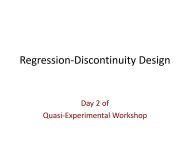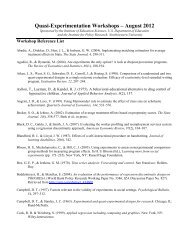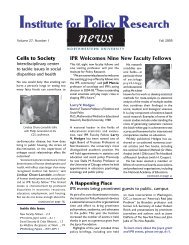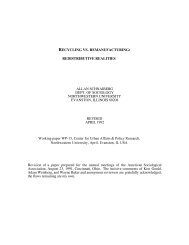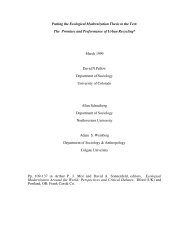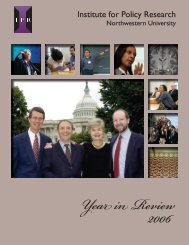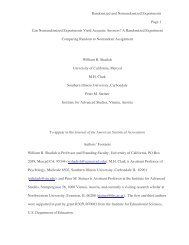Highlights of 2011 - Institute for Policy Research - Northwestern ...
Highlights of 2011 - Institute for Policy Research - Northwestern ...
Highlights of 2011 - Institute for Policy Research - Northwestern ...
Create successful ePaper yourself
Turn your PDF publications into a flip-book with our unique Google optimized e-Paper software.
Social Disparities AND Health<br />
period in the 1980s where it started to narrow, particularly <strong>for</strong><br />
African Americans living in the South. IPR economist Jonathan<br />
Guryan and his colleagues traced the gap’s narrowing to an<br />
unexpected source—integration <strong>of</strong> Southern hospitals in 1965.<br />
From the late 1950s into the mid-1960s, the death rate <strong>for</strong><br />
chronic but manageable illness. As part <strong>of</strong> her Health, Hardship,<br />
and Renewal Study, IPR sociologist and African American<br />
studies researcher Celeste Watkins-Hayes interviewed 30<br />
HIV-positive African American women between 2005 and<br />
2008. In this project’s first published study, she and her coauthors<br />
reveal how nonpr<strong>of</strong>it and government institutions, or<br />
“framing institutions,” play a critical role in helping these women<br />
to cope. These organizations provide conceptual frameworks<br />
<strong>for</strong> understanding what it means to have HIV, language to talk<br />
about their condition, and resources to begin restructuring<br />
their lives in the wake <strong>of</strong> a diagnosis. The authors also show<br />
how such institutions help the women to renegotiate their<br />
self-conceptions as black women after receiving another<br />
stigmatizing social marker. The study was written with Jean<br />
Beaman, an IPR postdoctoral fellow, and LaShawnDa Pittman-<br />
Gay, a postdoctoral fellow at Georgia State University and a<br />
<strong>for</strong>mer IPR graduate research assistant. It was published in<br />
Social Science & Medicine. The project receives support from<br />
the R.W. Johnson Foundation and National Science Foundation.<br />
Redefining Race<br />
on prenatal cigarette exposure, hospital desegregation and cognitive ability,<br />
outcomes. From left: moderator, Kellogg pr<strong>of</strong>essor, and IPR associate Therese<br />
IPR economist Jonathan Guryan; and MIT economist Michael Greenstone.<br />
black newborns was increasing in the South relative to the<br />
Northeast, yet postneonatal mortality rates plunged almost<br />
immediately after the hospitals integrated. The findings suggest<br />
that early health could be a time to narrow inequalities.<br />
MIT economist Michael Greenstone showed that the number<br />
<strong>of</strong> days exceeding 90 degrees in the United States will increase<br />
from an average <strong>of</strong> one per year to 30 by 2100. Examining U.S.<br />
death rates, Greenstone and his colleagues predict that moving<br />
a day from the 50-to-60 degree range into the 90-plus range<br />
translates to about one extra death per 100,000 Americans<br />
annually. In comparison, mortality data from India, a much<br />
poorer country with higher temperatures, indicates the same<br />
change in daily temperature averages leads to a death rate 10<br />
times larger. Since people in India are already dying from high<br />
temperatures, Greenstone predicted they are more likely to<br />
concentrate on raising incomes in the near future rather than<br />
on long-term investments to prevent climate change.<br />
Learning How to Live with HIV<br />
An HIV diagnosis is no longer a death sentence, with individuals<br />
now living <strong>for</strong> decades thanks to life-saving drug regimens. Yet<br />
many HIV-positive individuals grapple with how to transition<br />
from believing and behaving as though they have been<br />
sentenced to death to interpreting and coping with HIV as a<br />
Decoding the human genome has confirmed that human beings<br />
are not biologically divided into races. Yet in this supposedly<br />
“post-racial” era, race has taken on a new—and disturbing—<br />
guise, driven by pr<strong>of</strong>its, politics, and scientific probing, according<br />
to IPR law pr<strong>of</strong>essor Dorothy Roberts. She tackled this issue<br />
in her most recent book, Fatal Invention: How Science, Politics,<br />
and Big Business Re-create Race in the Twenty-First Century (The<br />
New Press, <strong>2011</strong>). In her book, Roberts underscores that race<br />
is a social and cultural invention. She reasons that it is not a<br />
biological category that naturally produces health disparities<br />
because <strong>of</strong> genetic differences, but rather a political category<br />
that has staggering biological consequences because <strong>of</strong> the<br />
impact <strong>of</strong> social inequality on people’s health. Key points from<br />
her research highlight this, including how race is being used<br />
in reproductive science, DNA-based criminal databases, and<br />
drug marketing. She points to how the pharmaceutical and<br />
biotech industries are poised to exploit race as a convenient<br />
but unscientific proxy <strong>for</strong> genetic difference to market new<br />
drugs. Roberts discussed her book in several events over the<br />
year, including at a lecture sponsored by IPR and the YWCA<br />
Evanston/North Shore.<br />
Racial Disparities in Causes <strong>of</strong> Death<br />
Currently, causal decomposition is the most common method<br />
used to estimate and compare death rates between groups <strong>of</strong><br />
people. This method, however, harbors a major flaw, according<br />
to IPR social demographer Quincy Thomas Stewart in an<br />
article <strong>for</strong> Mathematical Population Studies. It does not account<br />
<strong>for</strong> the fact that underprivileged groups are more likely to die<br />
from nearly all other causes <strong>of</strong> death, skewing the results. To<br />
correct this, Stewart developed the “cause-deleted index.” In it,<br />
23



